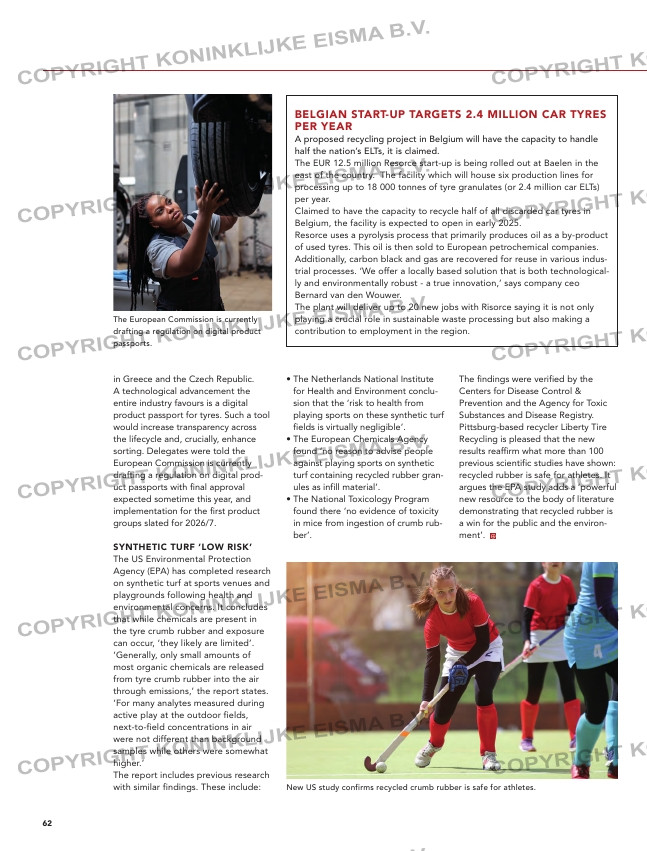Page 62 from: What’s inside?

62
in Greece and the Czech Republic.
A technological advancement the
entire industry favours is a digital
product passport for tyres. Such a tool
would increase transparency across
the lifecycle and, crucially, enhance
sorting. Delegates were told the
European Commission is currently
drafting a regulation on digital prod-
uct passports with final approval
expected sometime this year, and
implementation for the first product
groups slated for 2026/7.
SYNTHETIC TURF ‘LOW RISK’
The US Environmental Protection
Agency (EPA) has completed research
on synthetic turf at sports venues and
playgrounds following health and
environmental concerns. It concludes
that while chemicals are present in
the tyre crumb rubber and exposure
can occur, ‘they likely are limited’.
‘Generally, only small amounts of
most organic chemicals are released
from tyre crumb rubber into the air
through emissions,’ the report states.
‘For many analytes measured during
active play at the outdoor fields,
next-to-field concentrations in air
were not different than background
samples while others were somewhat
higher.’
The report includes previous research
with similar findings. These include:
BELGIAN START-UP TARGETS 2.4 MILLION CAR TYRES
PER YEAR
A proposed recycling project in Belgium will have the capacity to handle
half the nation’s ELTs, it is claimed.
The EUR 12.5 million Resorce start-up is being rolled out at Baelen in the
east of the country. The facility which will house six production lines for
processing up to 18 000 tonnes of tyre granulates (or 2.4 million car ELTs)
per year.
Claimed to have the capacity to recycle half of all discarded car tyres in
Belgium, the facility is expected to open in early 2025.
Resorce uses a pyrolysis process that primarily produces oil as a by-product
of used tyres. This oil is then sold to European petrochemical companies.
Additionally, carbon black and gas are recovered for reuse in various indus-
trial processes. ‘We offer a locally based solution that is both technological-
ly and environmentally robust – a true innovation,’ says company ceo
Bernard van den Wouwer.
The plant will deliver up to 20 new jobs with Risorce saying it is not only
playing a crucial role in sustainable waste processing but also making a
contribution to employment in the region.
• The Netherlands National Institute
for Health and Environment conclu-
sion that the ‘risk to health from
playing sports on these synthetic turf
fields is virtually negligible’.
• The European Chemicals Agency
found ‘no reason to advise people
against playing sports on synthetic
turf containing recycled rubber gran-
ules as infill material’.
• The National Toxicology Program
found there ‘no evidence of toxicity
in mice from ingestion of crumb rub-
ber’.
The findings were verified by the
Centers for Disease Control &
Prevention and the Agency for Toxic
Substances and Disease Registry.
Pittsburg-based recycler Liberty Tire
Recycling is pleased that the new
results reaffirm what more than 100
previous scientific studies have shown:
recycled rubber is safe for athletes. It
argues the EPA study adds a ‘powerful
new resource to the body of literature
demonstrating that recycled rubber is
a win for the public and the environ-
ment’.
The European Commission is currently
drafting a regulation on digital product
passports.
New US study confirms recycled crumb rubber is safe for athletes.
56-57-58-60-61-62_tyrestrendsbestpractices.indd 62 25-04-2024 09:36



